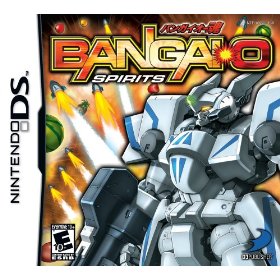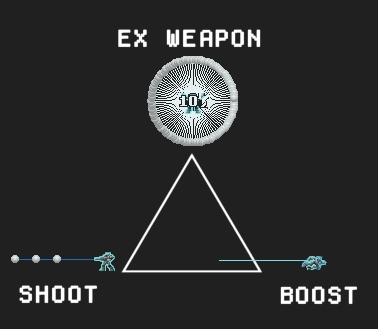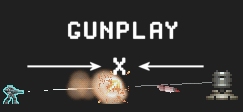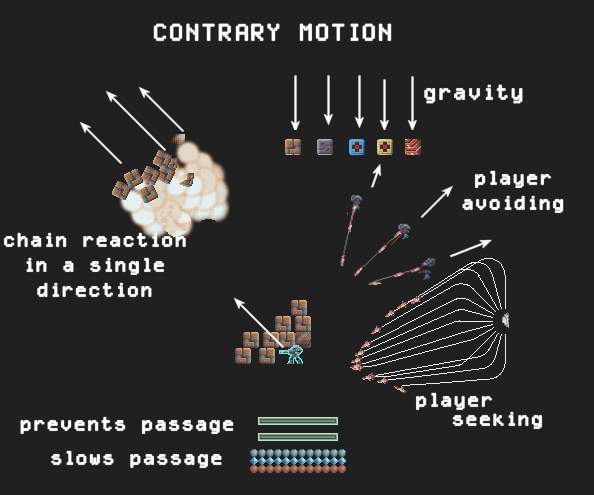Bangai-O Spirits Review
 Friday, October 17, 2008 at 6:42PM
Friday, October 17, 2008 at 6:42PM BANGAI-O! This game is undeniably explosive. With fond memories of conquering the Dreamcast game, I was curious t o know how Treasure's handled the transition to the DS sequel. It turns out Bangai-O Spirits is the best Bangai-O game in terms of features and core design. The stage editor, level sharing, and multiplayer options are features that put the icing on the cake. But the real meat of this DS sandwich is the core design. If you're not hungry for some action yet, then you might want to snack on fruit the size of a house. It's wacky in a way only the Japanese can create. Yet the gameplay and solid design is nothing short of Treasure.

Before we delve deeper into Bangai-O Spirits to try our hand at designing our own stages, I thought it would be helpful to go over a few points in this review. Some of the topics I'll cover in greater detail in the next Designer's Workshop lesson. Until then, enjoy this light review. BANGAI-O GO!
Core Design

- Primary Mechanics: SHOOT, EX WEAPON, and BOOST. Each of these mechanics (along with the MOVE mechanic) take up a unique design space giving the player a the complete definition of the missile based shoot 'em up combat. The SHOOT mechanic has unlimited ammo providing the player with more than enough firepower to take on any enemy in a duel. However, most enemies are positioned in group formations, and together they rain down more projectiles than the SHOOT mechanic can counter. By drawing in enemy fire and releasing the EX WEAPON attack just before getting hit, the player can launch up to a hundred missiles back at the enemies at once. The EX WEAPON attacks are limited so players have to use them wisely. Also, the EX WEAPON can be charged. The longer the charge, the more devastating the attack becomes. Finally, while using the BOOST mechanic the player speed increases. The increase in speed comes at a sacrifice to the ability to shoot. In this way, the BOOST is a great defensive move. The BOOST is also a close range melee attack. Like in Halo, the reward for closing in on an opponent and executing the melee attack in a shooting game is significant. In Bangai-O, players can BOOST into enemies to send them careening into other enemies while blocking enemy fire at the same time. The balance between movement, offense, defense, and decay keeps the primary functions functional creating a well-rounded core design..
- Tight controls. In the transition to the DS, the developers gave up the analog stick for the D-pad. Due to this hardware change, the movement and shooting controls are quantified to 8 directions. Though the change may feel old school, fortunately, the level design made the necessary adjustments to achieve effective, tight controls. Every element in the game is quantified according to a bit unit. By buildling according to this unit of measurement, everything in the game fits into a sharp coordinate plane. The visual presentation that results from the quantification creates levels that cleanly communicate their physical and spatial boundaries. At a mere glance, you know if you can move through gaps and how . Furthermore, to help players shoot at the angles in between the 8 directions, by holding the fire button the player can utilize some auto aim.
- Clean look. The graphics were kept to a minimum because Bangai-O pushes so much on the screen that the game can slow down to one frame per second. Though the screen can fill with enemies and their projectiles, because it all can be interacted with in a significant way, such an example does not fall under visual clutter.
Variation and Dynamics

- Excellent gunplay. Bagani-O is a missile shooter not a bullet shooter. For video game functionality, the difference between missiles and bullets is a big one. Missiles can collide with other missiles allowing for shot versus shot counters. Also, missiles come in a variety of shapes and styles (sidewinder, heat seaking, guided, fly by wire, napalm)0 while bullets generally have less variety. Like in Smash Brothers, projectile based attacks in Bangai-O can by countered with other projectile/melee attacks. Depending on the missile type, the gunplay can reach level 2 or 3. The counter attack with the EX WEAPON is another feature that adds to the gunplay in Bangai-O. Beyond missiles countering missiles, the Bat, Sword, and Shield can counter and even reflect enemy projectiles.

- Excellent spatial dissection. When setting up a counter attack using the EX WEAPON, it's best to position yourself with as many incoming attacks as possible before you activate the EX WEAPON. Because charging the EX WEAPON creates a stronger counter attack, finding the time to charge is directly tied to spatial positioning. For the best results, the player must move into a space where the most incoming attacks will be and get into that position with enough time to charge the attack. Furthermore, gravity is a constant factor that effects the player's position and some level elements. When all of these parts come together, space is defined by moving enemies, stationary enemies, homing attacks, level elements, and level obstacles. In this way, the contrary motion between these parts create a dynamic counterpoint out of gunplay.
- A wide variety of significant variation in weapon types and special moves. Homing, Bounce, Napalm, Break, Sword, Bat, Shield, Direct, Reflect, Freeze. Each of these missile/EX Weapon types changes the offensive and defensive strategies available to the player. Homing missiles seek stationary and mobile enemy targets. Napalm missiles detonate in lingering explosions that continue to cause damage. Bounce missiles rebound off of solid surfaces dissecting and redissecting space in dynamic ways depending on the environement. Break missiles have penetration power allowing the missiles to push through enemy attacks twice as effectively. The Sword and Bat are great for moving through enemy fire in a single direction, but using these attacks leaves the player's back wide open for attack. The Reflect EX Weapon can reverse the polarity of enemy missiles as well as send enemies and pushable objects careening. It's possible to send a whole wall of objects flying across the screen creating a dynamic, flying shield. The Freeze EX Weapon freezes all enemies and their attacks for a limited time. While frozen, enemy attacks don't do damage. In this way, positions and holes can be accessed in enemy defenses like never before.
- Transformable level elements. In Bangai-O, there are a variety of level elements that can be manipulated or destroyed by the player. Some materials you can only BOOST through. Depending on how this material is arranged, the resulting function can be anything from removing a ledge holding up bricks, breaking through doorways, opening enemy cages, to digging tunnels. Aside from these BOOST materials, Bagai-O also features bricks, blocks, and balls from various sports to knock around. Additionally, there are explosive materials that can be arranged to cause chain reactions.
Modes and Ways to Play
- 3 Ways to Play. For each level in Bangai-O Spirits, players can simply beat the level by destroying all the targets, go for a high score, or race for the lowest time. Just beating a level is the most open option in terms of strategies. Take your time, skip getting points, and goof off all you want before destroying the last target.
- When going after a high score the strategies change a bit. Time is not a factor in this case, so the player can focus on taking their time to collect all the fruit they can. The bigger and more devastating the EX WEAPON counter attack is, the more points the player gets for each fruit. (a fruit is left behind whenever an enemy, building, block, or gate is destroyed).To get more points, players have to position themselves to launch the biggest counter attacks that will destroy the most fruit yielding targets. Players must be careful though. The fruits don't hang around forever. Being able to grab as much fruit as possible also means controlling how many enemies you kill at once. If you destroy too many, you might not be able to collect all the fruit before they disappear. Also, if you don't plan an escape route to collect fruit in extremely pressured situations, you might be too busy defending yourself to collect them. Finally, each target in a stage that's destroy yields money that instantly doubles your current score. With just a little math, it's obvious that it is best to collect as much fruit/points as possible before collecting all of the 2x multiplying money bonuses. Doing so is easier said than done. Preserving targets to collect the money bonuses at the end is a strategy that forces players to control their fire power even more.
- When going for a the lowest time, coordinating the destruction of the enemies is unnecessary. To get the fastest time, BOOST as much as possible on the straightest path as possible while only stopping to destroy the necessary targets. Compared to destroying enemies for a high score, racing past enemies is much riskier. Depending on the level and how it might fold back on itself, going for the fastest run can make a given scenario significantly more difficult.
- Tutorial Mode. I must say that the tutorial for Bangai-O Spirits is very well designed. Each of the 17 levels in tutorial are focused on a specific facet of the game. Each level has a title and explanatory text that precedes it. The text is short and very informative. Though it may be a little overwhelming at first, all the nuances of the mechanics are explained via text. In this way, Bangai-O's high level gameplay isn't a secret that the player must figure out on their own. This keeps the player focused on developing the skills and playing the game to their fullest as quickly as possible.
- Puzzle mode: The mark of excellent player mechanics (nuances, dynamics, complexities) and level design is whether or not a game can create puzzles levels/areas. Wario Land 4, Super Mario Brothers, Advance Wars: Dual Strike, and Bionic Commando: Rearmed all have puzzle modes/levels/areas that accentuate specific facets of the player's mechanics through highly structured level design. 18 of Bangai-O Spirits 160+ stages are puzzle stages. Some of the puzzles are neat but very simple to solve and execute. Others set up interesting and complex challenges that are undermined by using the EX WEAPON mechanic to fill the room with missiles that, in turn, solved the puzzle somewhat automatically. Most, however, were top quality puzzles some of which are as well designed as some of the greatest puzzles I have ever experienced.
- Stage Editor: The interface for the stage editor is suprisingly simple and effective. The top screen displays the full map of the stage as well as some enemy data. The bottom screen contains a small movable pallet that makes creating a level as simple as painting. Touch an element (paint) from the pallet and touch (brush) the screen to apply that element. The editor is as full featured as possible allowing players to create the same quality of stages that come with the game.
- Three top quality learning tools at the player's disposal. In any level and at any time outside of the tutorial mode, the player can activate the slow or edit mode. In the slow mode, players can advance the game one frame at a time. By controlling the speed of the game, players have more time to understand the sometimes myriad of interactions happening on the screen. The edit mode allows the player to change anything about the level and play it immediately. If you want to practice a later part of a long stage, simply activate the editor and drag the player character to the next area. If you want to try out a challenge with just one less enemy bothering you, take him out of the equation. With these two features, the player is in complete control of a given situation so that they can learn and develop their skills their own way. Finally, the save replay feature is always nice to review your play to figure out what you could have done better.
Bangai-O Spirits is an action game masterpiece showing us that graphics and processing power aren't what makes games great. It's all about quality design from the very core to each and every one of its features. With the review out of the way, it's time to start building levels of our own in the Designer's Workshop. It's going to be a blast.
 Bangai-O Spirits,
Bangai-O Spirits,  Shmup in
Shmup in  Dynamics,
Dynamics,  Mechanics,
Mechanics,  Review,
Review,  Variation |
Variation |  Permalink |
Permalink |  Print Article
Print Article 

Reader Comments (3)
Stonking great article. Keep it up!
Bangai-O Spirits is certainly one of the best games of it's decade, but I'm certain that if it was available in a home console, it would one of the greatest games of all time. It's a shame, seeing such a wonderful and incredible amount of good ideas being dropped on such a limited hardware.
@ alvare
Do you think better graphics would make that big of a difference for you? Or is it a smoothness issue? Cause.... I like the slow down. And even the Xbox360 version can slow down. It's really a stylistic choice.
I think Treasure really likes working with limited hardware.